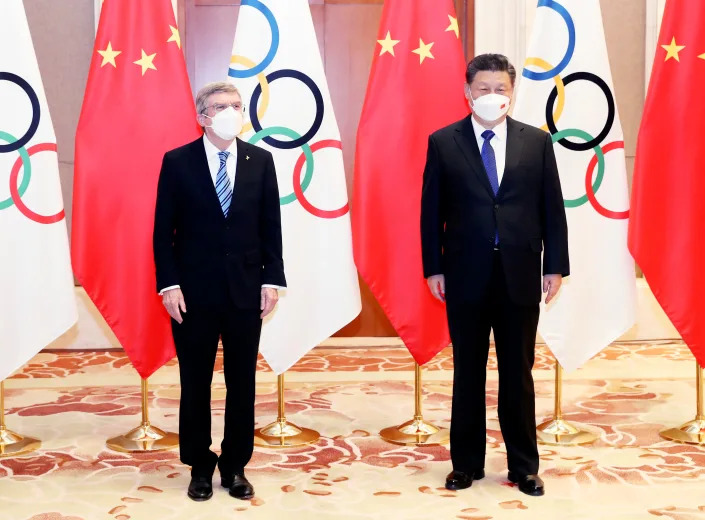Opinion: Olympic movement has sold its soul by not challenging China on human rights abuses
The Olympic Games can never be seen in the same way again. Once aspirational, radiating hope and the promise of all that could be, they have been tainted by the crass calculations of their leaders.
The International Olympic Committee has sold the people of China out, refusing to hold the hosts of next month’s Winter Olympics accountable for a litany of human rights abuses and, worse, providing cover for some of the atrocities. In doing so, it has sold itself and its ideals out, too.
“We know they have very close relations with China, we know it’s very corrupted. But we didn’t know (the IOC) would not only be silent but actively collaborate with the Chinese government,” Badiucao, an artist-dissident who had to flee China because of his criticism of the government, told USA TODAY Sports.
“It’s really ridiculous that we have the organization in charge of the Olympic Games, championing it as an event celebrating humanity and saying sportsmanship is more than just entertainment. How can it be so corrupted and play along with this evil regime, this evil government?”
In a word? Greed. In another? Expediency.
China is an economic powerhouse. It is the world’s fastest-growing consumer market and its largest manufacturer, and two Chinese-based companies are now among the IOC’s TOP sponsors. The last thing IOC members, partial to five-star hotels and first-class cabins, want is to alienate that growing source of wealth.
And when it came time to award the 2022 Winter Games, few other countries wanted them.
Several in Europe considered bidding only to say “Thanks, but no thanks.” By the time the vote was taken, the choices were Beijing or Almaty, Kazakhstan. Having dazzled the world with the Summer Olympics in 2008, and knowing the Chinese government would spare nothing and no one to do it again, the IOC saw Beijing as the safe and easy choice.
All it had to do was turn a blind eye when China suppressed dissent among its people. Stripped Hong Kong of its autonomy and cracked down on religious freedom in Tibet. Imprisoned more than a million of the minority Muslim Uyghur population and subjected them to slave labor, forced sterilization and abortion.
And, in the last few months, help China whitewash its silencing of tennis player Peng Shuai, a three-time Olympian.
When criticism of the Chinese was at its most intense, and there were calls for substantive responses to the disappearance of Peng following her allegations of sexual assault by a former senior Chinese official, IOC president Thomas Bach staged what was essentially a photo op with her and declared that she was fine. Peng still has not spoken freely, and she has essentially been erased from Chinese social media.
“It shows us pretty clearly that the IOC is not serious when it comes to human rights concerns,” said Michael Mazza, a visiting fellow at the American Enterprise Institute.
“Yes, it will be a stain on the legacy of the IOC and I think it will be a stain on Thomas Bach’s legacy, in particular.”
Bach will defend the IOC’s shameful inaction by saying the Olympics are supposed to be above politics. Yet he plays politics when he wants to, brokering a truce between North and South Korea ahead of the 2018 Games in Pyeongchang.
And high-minded as the idea of Olympic neutrality is, it was politics that brought the Games into being, both in ancient times and the modern era. The Olympics were seen as a way to create unity among warring peoples, to make them see their enemies in a different light.
“O Sport, you are peace!” Pierre de Coubertin, the founder of the modern Games, wrote in his poem, Ode to Sport. “You forge happy bonds between the peoples by drawing them together in reverence for strength which is controlled, organized and self-disciplined. Through you the young of all the world learn to respect one another, and thus the diversity of national traits become a source of generous and peaceful emulation.”
Now Olympic leaders stand by while the host nation wages war against its own people.
“They’re going to have to do a lot of brand protection, brand rebuilding, after this sequence of events,” said David Black, a professor at Dalhousie University whose areas of expertise include the politics of sports and governance.
“They felt themselves as having little choice but to take the line that politics should not intrude, but clearly politics have intruded. And could have been anticipated to have intruded.”
Because we have been here before.
When China was bidding for the 2008 Olympics, part of its pitch was that hosting the Games would lead to democratic reforms and an improvement in human rights. Yet before the flame was even lit, the government had gone back on that promise, and experts say conditions now are even worse.
“There’s nobody left to lock up,” said Sophie Richardson, Human Rights Watch’s China director.
“Xi Jinping’s government has worked so assiduously since (China) was awarded these Games to just crush independent civil society,” Richardson said. “Most people who could have or would have wanted to try to find ways to protest around these Games have already been arbitrarily detained, disappeared or driven in to exile.”
The IOC has rare leverage with China and other autocratic nations. Hosting an Olympics is an immense source of pride, a declaration of their status as a world power. Even the threat of taking that away would be a colossal embarrassment, one a country like China would do almost anything to avoid.
But the IOC backed down from challenging China in 2008. This time around, it didn’t even bother to try.
“The IOC is dishonest and duplicitous and weak,” Richardson said, “and perfectly willing to sacrifice the people who are doing the hard work to try to make the kind of change in China that the IOCs of the world say they care about.”
The United States, Canada and a handful of other Western nations have announced diplomatic boycotts of the Beijing Olympics, their only way of showing condemnation without punishing their athletes. But sponsors have been silent, dodging questions by reporters and human rights groups alike, and COVID protocols are such that, if there are protests during the Games, they will go unseen.
So the Beijing Olympics will go on. The athletes will bring us to cheers and stun us into silence with their performances, and China will stage another spectacle grand enough to hide the ugliness that occurs when the world isn’t watching.
Almost.
“Obviously, this Olympic Games is not stopping. It will be happening in China,” Badiucao said. “But the power is in our own hands. When the whole entire world has shifted their camera and is focused on China, let’s talk about China and not be fooled by its propaganda.
“We could,” he added, “turn this into an opportunity.”
The damage has been done, however. Much like the 1936 Games in Nazi Germany, now seen as an affront to the Olympic ideals, the 2022 Games in Beijing will forever leave a stain on the Olympic movement, and those who allowed it to happen.
Follow USA TODAY Sports columnist Nancy Armour on Twitter @nrarmour.
This article originally appeared on USA TODAY: Olympics will never be the same because of China's human rights abuses









